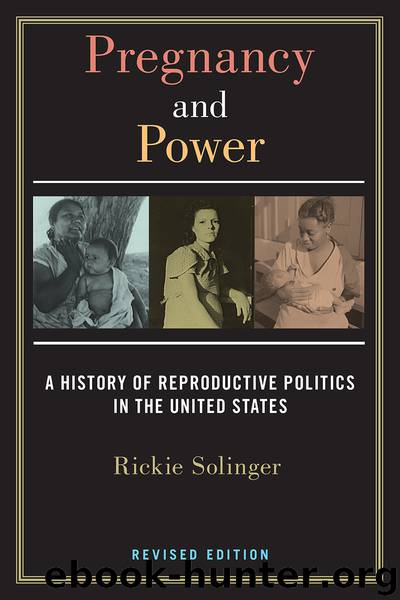Pregnancy and Power, Revised Edition by Solinger Rickie;

Author:Solinger, Rickie;
Language: eng
Format: epub
Publisher: New York University Press
The End of the Line for Criminal Abortion
Ladner and others were beginning to imagine and speak publicly about a world in which women could legitimately and legally make a great many fertility-related decisions as individuals on their own behalf. Two related, very public events in the early 1960s made the basic idea of female reproductive self-determination—including access to legal abortion—more visible to Americans, more attractive, and more understandable than before. One was the terrible rubella, or German measles, epidemic of the early 1960s, a public health event that put many pregnant women at risk of delivering babies with health problems (e.g., eye problems, hearing problems, and heart damage). The other was the so-called Sherri Finkbine, or thalidomide, episode in 1962; the issue helped many Americans understand why any woman might feel the need to manage her own fertility.
In this case, Sherri Finkbine, a married woman and a mother of four, living with her husband and kids in a suburb of Phoenix, took some antinausea medication that she thought was harmless. Soon, though, she realized the pills she had taken to relieve the morning sickness that had come with her fifth pregnancy contained thalidomide. Scientists had recently identified this compound as causing dramatic fetal anomalies, such as babies born without arms and legs or with fatal heart anomalies. Sherri’s doctor advised her to have an abortion. At first her hometown hospital agreed to allow a doctor on staff to perform the operation, but a few days later, fearing a legal situation that might harm the hospital, the facility’s administrators decided not to permit the abortion.
By this time, though, Finkbine was determined to end her pregnancy. Also by then, Finkbine’s case had become public. She had made a public statement thanking the Phoenix newspaper for running the news article that had alerted her to the contents of the drug she had taken by mistake. Reporters gathered around the Finkbine house, waiting to hear the hospital’s next move and report on Finkbine’s reaction.
When Finkbine and her husband, Bob, investigated their options, they found that their best chance for obtaining a legal abortion was to go to Stockholm. There the Royal Medical Board of Sweden had approved two thousand out of four thousand requests for abortions the previous year, a rate much higher than any U.S. hospital abortion board. Ultimately, the board approved Finkbine’s abortion, and the Swedish doctors found that the fetus she was carrying was in fact deeply damaged.
Finkbine’s case captured the attention of America partly because she spoke publicly about a subject that women of that day only whispered about to their best friends, their husbands, or their boyfriends. Also, Finkbine spoke only in terms of a mother’s duty to spare a damaged fetus from a painful life. She did not raise thoughts of sex-gone-wrong or even of women’s rights. Even though she didn’t say it, she implied that a woman—especially a well-dressed, attractive, middle-class, married woman, a mother of four, like herself—could justifiably make a choice about a pregnancy that had already taken hold.
Download
This site does not store any files on its server. We only index and link to content provided by other sites. Please contact the content providers to delete copyright contents if any and email us, we'll remove relevant links or contents immediately.
On the Front Line with the Women Who Fight Back by Stacey Dooley(4697)
The Lonely City by Olivia Laing(4569)
The Rules Do Not Apply by Ariel Levy(4524)
Bluets by Maggie Nelson(4261)
The Confidence Code by Katty Kay(4040)
Three Women by Lisa Taddeo(3278)
Inferior by Angela Saini(3151)
Not a Diet Book by James Smith(3149)
A Woman Makes a Plan by Maye Musk(3144)
Confessions of a Video Vixen by Karrine Steffans(3100)
Pledged by Alexandra Robbins(3047)
Wild Words from Wild Women by Stephens Autumn(2936)
Nice Girls Don't Get the Corner Office by Lois P. Frankel(2934)
Brave by Rose McGowan(2736)
Women & Power by Mary Beard(2614)
The Girl in the Spider's Web: A Lisbeth Salander novel, continuing Stieg Larsson's Millennium Series by Lagercrantz David(2613)
Why I Am Not a Feminist by Jessa Crispin(2583)
The Clitoral Truth: The Secret World at Your Fingertips by Rebecca Chalker(2583)
Women on Top by Nancy Friday(2446)
